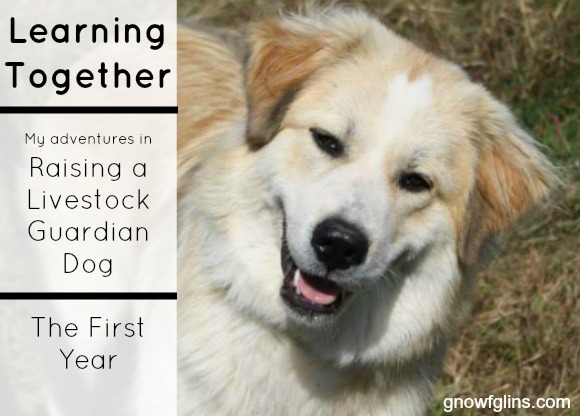
The following is not intended to be a tutorial, how-to, or training manual. I am simply sharing my experience in raising my livestock guardian dog (LGD) puppy, along with a few good resources that I’ve used along the way. –Lindsey
January 5th marked one year since Mindy, our Great Pyrenees/Karakachan dog, came to live with us at Hickory Cove Farm. I thought and prayed about getting a livestock guardian dog for quite a while, and had joined a few Facebook groups that specifically focused on LGD-raising as a way to “get my feet wet”. I thought that I would sit back and observe, read others’ tips and stories, ask a few questions, and keep an eye out for an available puppy with the right price and location.
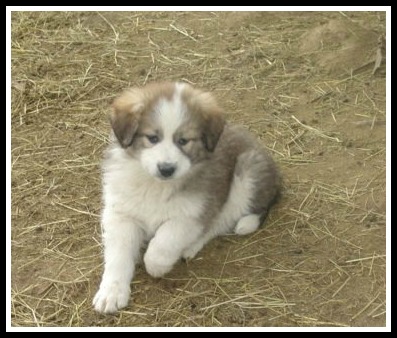
Then one day, this picture showed up in the group, and I melted. An 8 week old fluff ball, the last of the litter, located in Tennessee. The price was right. The location wasn’t the most favorable, but that could be worked out.
I sent a message to the breeder, Myron Stephens from High upon the Mountain farm, and told him that if I could find a way to get her from Tennessee to Pennsylvania, I’d take her.
Myron told me about the Small Animal Transport group on Facebook, so I posted a request in the group. Within a day or so, I had a response from a lady doing a transport run all along the East Coast, and with that final detail worked out, I suddenly went from someday-dreams of having an LGD to having one on her way to me.
We spent the week getting ready for her arrival and setting up a pen for her in the barn.
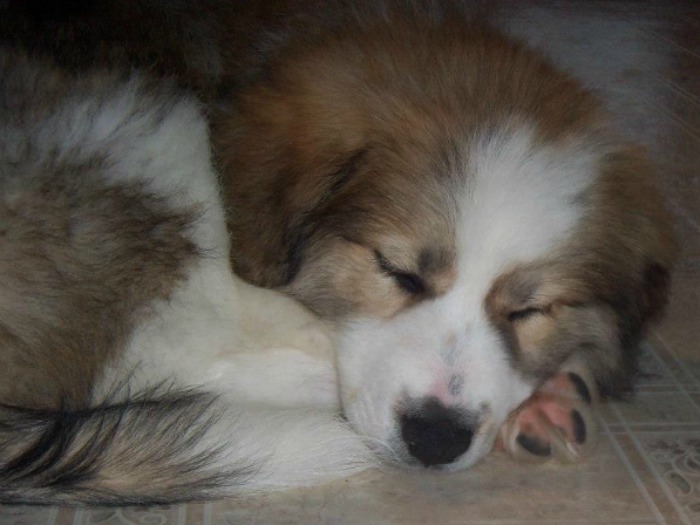
She arrived late at night, and spent her first night here in a large crate in the house. The next day, at Myron’s suggestion, we gave her a bath to wash away the scents from her birth farm, dried her off, and then it was time to move her out to the barn. She was well-behaved when she first met the goats, which is a good thing, because the goats sure were scared of her!
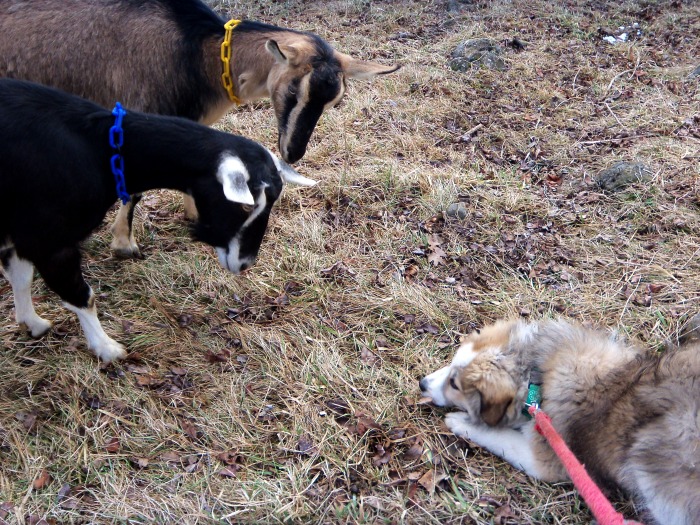
We set up a pen for her in the barn so that when we weren’t supervising her with the goats, she’d still be able to see them, touch noses with them once they were brave enough to let their curiosity get the best of them, and bond with them.
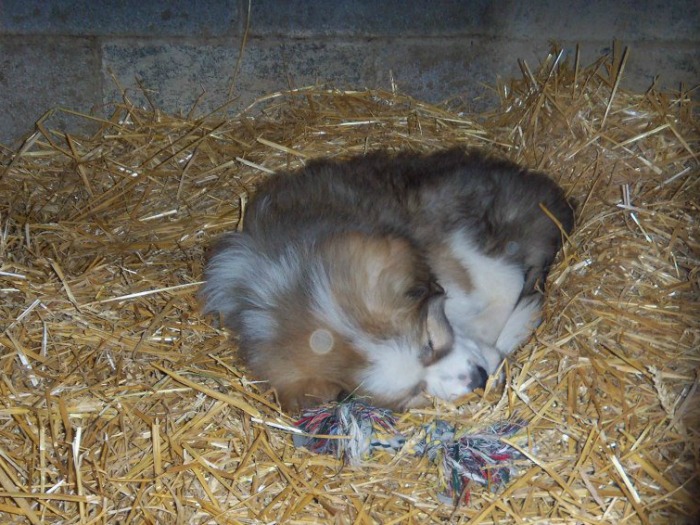
My Training Method
First, I must say that I’m not a fan of the “hands off” approach to training a LGD, as I believe that the dog can and should be well-socialized and bonded to their owners, as well as to their stock. Mindy is not only a protector for the livestock, she’s my dog — my companion.
In the early days of her puppyhood, we spent as much time running in the pasture and playing together as we did in training sessions. I actually found it worked best when we spent 15 or 20 minutes playing together before going in with the goats for awhile, as it helped her to burn off some excess energy.
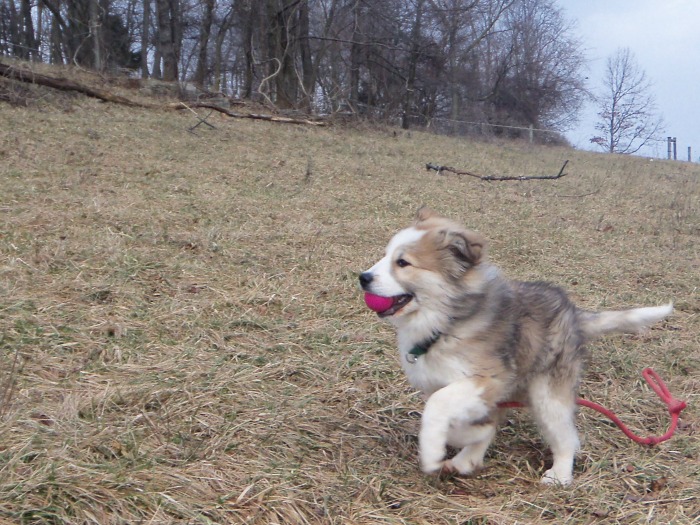
After our playtime, we got to work. For the first several months of training, Mindy was only in with the goats when I took her in there, and she was always on some sort of leash, either a regular, short dog leash or a 30-foot line, depending on what we were doing.
At first, we worked on just being still while the goats got used to the dog being in their space. Then, we’d walk slowly through the group. I would watch Mindy’s body language for cues of submission and bonding (ears back, head down, showing her belly, licking the stock) and made sure to praise her liberally when I saw her doing a good thing.
Eventually, we moved on to the next phase of training, where I’d take her into the pasture, drop the end of her leash, sit, and observe the goings-on. It has been fun to watch her natural instincts blossom.
Correction Method
One of the most often recommended ways of training a LGD to behave with the stock is to verbally correct them when they start to chase, and immediately take them to their pen. Eventually, the dog will learn that not only will they get to be with their charges when they behave, but undesirable behavior means swift and sure time-out. This is the method I chose to use as well.
Mindy went through phases where she spent a whole lot of time in puppy jail… Though it was hard for all of us, I knew it was a normal part of her two-year-long puppyhood. According to my reading, there are three or four regression stages that a LGD puppy goes through as they mature into a working guardian. These regression stages have been frustrating for sure, but each time she goes through one, she comes out of it a better dog than she was before.
Making Progress
Finally, I felt comfortable leaving Mindy alone in the pasture with the goats. This time I supervised only from a distance. When I worked outside, or at a place in the house where I could easily see her, I allowed her to be in the pasture with the goats. I still kept a close eye on her, and was able to verbally correct and remove her when needed.
During some of this time, Mindy wore what is called a dangle stick around her neck. Made out of a length of PVC pipe, two eye bolts, and zip-tied to a collar, this device dangles in front of the dog’s chest. The main purpose of this is to function as an anti-chasing device, because it taps against the dog’s chest when they run. They don’t like this, and it doesn’t take long for them to figure out that they can stop it from happening by simply not running. I like that it provided an immediate consequence, and that she basically taught herself not to chase the stock.
Although Mindy has grown in so many ways in her first year here, her training isn’t quite over. She still has one more year of puppyhood, and I expect at least one more regression stage. She’s still learning that the barn belongs to the goats, not her, and that she needs to allow them to come down from the pasture, get a drink, munch hay, and lounge. She’s not yet with the stock full-time, and has not yet spent a night with them without being tied up or penned. But she’s learning. I’m learning. And together, we make a good team.
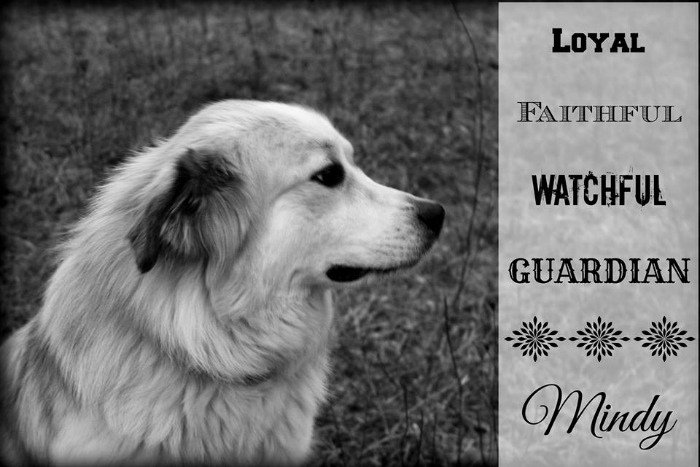
UPDATE: Shortly after publishing this article, we welcomed another LGD onto our farm. Duke is a 6 year old Maremma/Anatolian Shepherd mix who has spent his whole life with livestock. When his previous owner sold most of her sheep herd due to her upcoming marriage and move, Duke was left without a job on their homestead, and we were more than happy to give him a job here. He has done a great job of both guarding our livestock and taking over my role as Mindy’s teacher, and they have grown to be a perfectly matched, well bonded team of livestock guardians
Resources
There’s no way I would have any idea how to handle and train a LGD without the following resources! I’ve found them all to be a great help.
Learning About LGDs — This Facebook group has been a great place to ask questions and gain knowledge by reading posts and comments. The files section contains a wealth of information, and the cute photos are a fun plus!
LGD Help — This is the Facebook group where I first saw Mindy’s picture. Like the Learning About LGDs group, this one is a great place to watch and learn. Again, make sure to check out the files section because there are lots of gems tucked away under that tab!
Livestock Guardian Dogs — While it’s not the easiest site to navigate, this little corner of the web has great overviews on many different LGD breeds. I used it to help narrow down the list of breeds I wanted. Make sure to visit their extensive library section as well.
Livestock Guardians: Using Dogs, Donkeys, and Llamas to Protect Your Herd by Jan Vorwald Dohner — I borrowed this book from a friend and found it to be interesting and helpful. The breed overview section and training tips are extensive and very nice. As mentioned in the title, it also includes sections on other guard animal options.
Livestock Guardian Animals: Donkeys, Llamas, and Livestock Guardian Dogs to Protect Your Property and Stock by Jim Mitchell — This eBook was a recent find, and I quite like it. My favorite part is chapter three, written from the viewpoint of the author’s two Maremmas, Augie and Callie. The eBook is short, but it has good information.
Do you have a livestock guardian dog? Are you considering adding one to your homestead? If you are an experienced breeder or trainer, do you have any tips for those of us still learning?
We only recommend products and services we wholeheartedly endorse. This post may contain special links through which we earn a small commission if you make a purchase (though your price is the same).


We don’t have one yet but we have talked at length about getting one. Currently we have four shih-tzus that are house dogs. We’ve wondered about a larger outside dog for the farm and how he/she would get along with the current pack. I think our biggest decision at the moment is deciding which scenario would work best for us. At this point we just have chickens, I don’t know for sure whether or not we’ll venture into goats or sheep. I have wondered if a LGD would work with the girls as I would like to be able to let them free range our ten acres and have a guard for their coop at night. On the other hand, I don’t know if a herding dog would work better, or just a plain ‘ole watch dog. That being said they are a beautiful breed and I think they would make a great addition to our homestead. I’ve read the book by Jim Mitchell and found it to be very helpful. I’ll check out the other resources you’ve mentioned as well.
From what I’ve read, Maremma Sheepdogs seem to be the most popular choice of LGD breed for poultry guardians and they do great with goats and sheep, too. I’m always hesitant to recommend a herding dog for guarding, because they really have different purposes – herding dogs are for helping the farmer move stock, not really for guarding against predators, although they sometimes do that too. Herding dogs don’t really live with the stock full-time, they’re just an extra set of hands (paws?) when the farmer needs help. 🙂
As for a good ol’ farm dog – again it really depends on the dog. The key difference with LGD breeds vs. others is that LGD’s have a low prey drive, whereas other dogs have higher prey drives so chasing and playing with the stock will probably be more of an issue, even well into adulthood. That said, there are success stories where non-LGD breeds have been trained to be trusted with stock – it’s just more of a gamble that way.
I agree and wanted to chime in a little as well. I keep chickens and we have a border collie, who we had before we got the chickens (ie she didn’t grow up around them). I think we got lucky, she doesn’t have the typical high energy disposition of a typical border collie. I never had any illusions about her being a LGD, but I did want to see if I could get her used to the chickens so they could free range while she was outside without any mishap, so I used a lot of LGD training tips to acclimate her. She is really great around the chickens- she only ever tries to get chicks, and as long as the chicks are well enclosed or even just with a good broody, she’s fine. Other than that the only problem I have had is that she likes to get into their pen and eat their feed 🙁 I agree, though, that the instincts of a herding dog are not right for protecting, and with chickens I’ve heard the instinct to herd them coupled with the flightiness of the birds can have disastrous results.
So far as just a generic farm dog, it just depends. I would STRONGLY recommend staying away from any birding/hunting dogs (especially the most common dogs- Labs and Retrievers). I had a lab for a while (who unrelatedly died young, which was sad, but a tiny part of me was relieved because of the chicken related stress he caused me) and it was a HUGE mistake, even though I did all the same gradual introduction things to acclimate him to the chickens. It is next to impossible to overcome the kind of prey drive those dogs usually have. I got to a point where he could be outside off leash when the chickens were out, but only if I was around, never on his own. Strangely, we got kittens when he was just over a year, and it was 100x harder to train him to not kill the kittens than it was with the chickens, but his mother had been a hardcore cat and rat killer, so that may have something to do with it. I’ve heard that Coon Hounds can be good with chickens, as they won’t bother the birds but will usually chase off other things, but I don’t have any experience to back that up.
We have two LGD. They are both part Great Pyrenees and part Anatolian Shepherd. They are wonderful dogs. Very intuitive. Protective of our goats. They have a sense of what animals belong to us and where each of them should be. They like a routine, to know what to expect. They are wonderful companions to us as well. They are harder to train than other dogs, and I find that “playing” with them is not like other dogs as they are not motivated by treats or toys, but they do want to be with us and to please us. We love having them.
Maybe this is silly, but since I’ve always just had companion dogs I struggle with the idea of leaving an LGD out all night when it is frigid. I know they are bred for it, but it is still so hard to get my head around. 🙂
I know its hard to leave them out, especially in the frigid cold and the blistering hot nights but I try to keep my mindset like this:
– they don’t want to be away from the flock
– you’ll ruin them if you make them an indoor pet
– they have a thick coat, they wont be too cold
– I have blankets for them
– I can invest in a/c fans for them.
– THEY ARE DOING THEIR JOB!
There are all these reasons I try to get in my head that makes it okay for them to be outside. The last one is the hardest to wrap my mind around but there are meant to be in the great outdoors. If they try to go with me, that’ll be hard, but they are meant to protect the barn-yard. Not inside your house, on the sofa, watching tv w/ you at 3am. Not saying they are allowed on the couch but that besides the point. ?
This was such a fun read! Kinda makes me want a LGD of my own!
We have an Anatolian Shepherd we got at 8 weeks old and have have since just before Christmas 2012. He is great with the goats and sketchy with the chickens – we have to keep them apart since he likes to chase them. Since getting a rooster that has pretty much stopped as the rooster has popped him on the large puppy nose a couple times.
Having him out there keeps my mind at ease, as we have had mountain lion attacks in broad daylight, down the road just 1/4 mile last spring. Just last week my DH was saying we should get another to make sure the coyotes and javalinas (wild pigs that roam and destroy stuff and small animals) don’t get too aggressive trying to get on the fenced property. I guess he is sold on them as well !
Thanks for bringing more folks’ attention to this great group of working dogs!
Susan in Southern AZ
Looks like Mindy is a wonderful dog! It really is amazing when these dogs hit the 2 year mark. We have two Pyrenees/Bernese Mountain Dog mixes, and a little 5 acre farm, but surrounded by huge acreage. We have personally broke the rules as far as LGD but with only a few animals that are kept in the barn overnight the dogs have turned out to be fantastic all around farm dogs. We do have 4 young children that are really the main “herd” my dogs watch over. We have worked with the dogs to respect the animals and have never had a problem, but the pup is only 7 months at this point – yet he does follow the older female’s lead. At 18 months we saw the older dog’s instincts and desire to work really kick in and she has been amazing, she patrols the property and can go from “sleeping” to a full run when she senses something wrong in a matter of seconds. Because we have so many visitors she has been socialized but really knows the difference when someone is invited vs. not. We have fox, coyote, bear and mountain lions in our area but have seen none since the dogs have been fully grown. I realize that a true LGD should be raised differently and if we had a larger flock or more land we would surely follow those guidelines. But I do have to say that for our purposes of an all around family farm dog our mixes have been a fantastic addition to our farm!
Excellent post! We went about things differently when we brought our LGD pup home a few years ago. He went immediately in with the goats/sheep and the issue was creating a safe place for him to get away when he was overwhelmed. Once we had that, he was one happy pup.
We didn’t use the isolation technique either, and even let him play with our house puppy (only when we were in the pasture, and they weren’t allowed to rough house near the livestock or leave the pasture). I found that really helped burn off his energy and it didn’t change his feeling of “home” with the sheep/goats, i.e. he didn’t try and leave the pasture when they were done playing and we left with our house pup.
I suppose my two biggest tips would be make sure you have an animal in your flock that won’t take any guff from a young pup. That is really helpful in teaching them boundaries, especially with sheep where they have thick wool that is fun to pull on.
The second tip is to fully embrace that this dog is livestock. He/she doesn’t come in the house, doesn’t leave their guardian animals to go on chores with you and if you choose to get out of the goat/sheep/whatever business, they WILL have a hard time adapting without their animals. When we sold off our goat herd, we re-homed our LGD with one of the wethers. He’s now guarding a big herd with another LGD and is super happy. At the time, I tried keeping him and a wether until we brought on more animals…but they were both miserable.
Tough choices and so so incredibly different than having a “pet” dog. Another thing we found helpful was buying a remote shock collar that has a vibrate function. When our guy was going through the jumping stage, just a few vibes from that and he learned not to jump. That requires really good timing and that you can watch your dog from afar.
Very interesting. We have an inside malte-poo right now, but as we go through the process of moving to larger acreage and homesteading, we have talked about getting a working/guardian dog. While I’d like dog that can guard poultry and cows, our main livestock interests, I have soon-to-be-five little children that I would like the dog to be socialized to and be companions to. I obviously have a lot of research to do, but it sounds like there are dogs that can be trained to be good with livestock and humans. Thanks for a great informative article.
I have been involved with livestock guardian dogs for over 16 years. From taking in hard core rescue livestock guardian dogs, to ‘re-shaping’ or ‘re-training’ livestock guardian dogs who were called Failures, Worthless, etc. and showing them the RIGHT way, the RIGHT road to success. …. And success they are!
From mentoring people, all over the world, on the right and true way to be successful with your livestock guardian dog, to importing, breeding and raising Maremma Sheepdogs for people all over the world. This is my passion and my experience that I am sharing over and over. True success that works.
I have also written a “Livestock Guardian Dog Training Manual”. It covers puppies, ‘problem’ stages and ages, commands, feeding, setting your dog up to succeed, body language, tone, YOUR part as the owner, etc. It can be purchased on our website
http://www.windancefarms.com or through Amazon.
Livestock Guardian Dogs are amazing. They are intelligent, loving, wonderful PARTNERS – who risk their lives for you, your family and your stock – each and every day. We owe them so much for what they do for us – and setting that dog up for success is such a huge part – instead of setting it up to fail – and then labeling that dog as a failure… saying that dog is unable to BE a livestock guardian dog. When it CAN be! When that dog understands that THIS road is to success and THAT road was towards failure.
There is nothing like it when the dog understands – it is like a light bulb going off! And I smile, sigh deeply and sometimes cry at the joyful sight of another dog who was just misunderstood.
Enjoy them, love them, learn what to do to have success – what JOY!
Great post! Good observation, information and positive encouragement. I like your patience in letting your dog grow up. Many folks have compared an adolescent dog to a teenager. They still need guidance and supervision!
Do you have any pictures of Mindy as an ‘adult’ dog? Our Great Pyrenees just birthed nine Karakachan mix pups and I’m curious how their badger markings might turn out. Right now they are quite dark. The papa Karakachan has chestnut markings. Thanks!
We LOVE our Karakachan mama, Great Pyrenees papa, and their gorgeous puppies! So smart, sweet, easy going (unless they perceive a threat!), and are incredible around our chickens, goats, and cows. They help with deliveries, let goat kids use them as trampolines or “climbing rocks,” love their jobs, and learn very quickly. Our large animal vet recommends them to his clients. Missy happens to be short- haired, which is great in this central Virginia climate. While youngsters, some have chased the chickens around, but we’re quickly corrected by us or another dog. We have occasionally had to remind them we are the heads of the pack. They actually seem relieved to know this.
Another interesting side note is how quickly they heal. One of our guys who was a rescue and is 3/4 Karakachan and 1/4 Pyrenees was basically slapped by what could only be a mountain lion. I say this, because Virginia has yet to officially recognize the presence of this predator. They are here. Our guy lost an eye from a puncture wound, had multiple wounds on one side of his face, a tooth knocked out, AND a broken jaw. We can only think that they surprised one another, as there was not much more evidence of any blood or injury. The vet who wired his jaw and removed the damaged eye was absolutely SHOCKED at how quickly he recovered after surgery (2 hours later he couldn’t believe how much he had improved.).
Our Karakachan has unfortunately gotten too old for puppies, though. 🙁 We will one day be looking for another.
I also live in Virginia. I have never had a LGD but I’m in the process of getting one for our new farm. We have chickens and dairy goars but will be soon adding cows. I’m having a dilemma picking a purebred Great Pyrenees puppy or a Pyrenees, Karakachan,Merama mix puppy. I’ve always owned nothing but purebred because sometimes when mixed breeding you get bad temperaments. I’ve heard a couple people say that the mixed breed of the Pyrenees, Karakachan,Merama mix is a great combination. Do you bbn have any suggestions on this?
We have a mix LGD which is half karakachan and a quarter or so each of pyreneesand maremma And he is amazing. My husbands parents bred their karakachan and Pyrenees maremma mix and all of the dogs were kind, hard working, diligent and extremely intelligent. We love them.
I also would argue the idea that mixed breeds can have bad temperaments